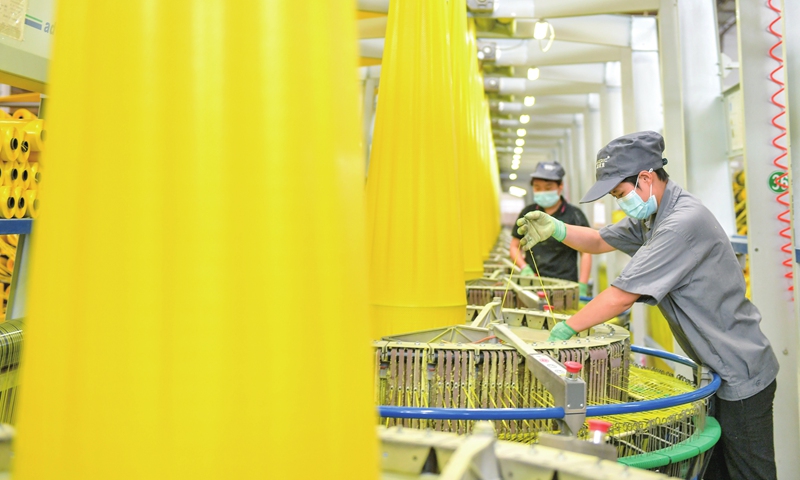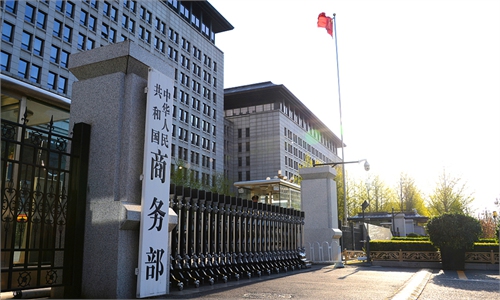
Employees of an environmental technology firm in Huzhou, East China's Zhejiang Province operate high-speed circular looms on Tuesday, churning out plastic bags to be shipped to Indonesia. The firm has introduced a one-stop digital management platform to enable more efficient quality tracing, with its high-tech green packaging items taking a firm hold in the Yangtze River Delta region and being in great demand in markets along the Belt and Road Initiative. Photo: cnsphoto
The big strides China has made in its technological capability serve as a pivotal buttress of accomplishing xiaokang, China's minister of science and technology said on Tuesday, highlighting sci-tech-powered job creation and a boost to economic growth, especially in western China.
With advances ranging from 5G to aerospace laying the groundwork for breakthroughs to be made in core technologies, the country is supposed to double down on efforts to get a head start -- notably on the US -- in visionary technologies that will drive future growth, observers said.

Big leaps in China’s technology strength and innovative capabilities are the foundations to accomplish a moderately prosperous society, or xiaokang, China's Minister of Science and Technology said on Tue.
The country has held to an objective approach and relied on scientific and technical innovation to address the issue of imbalanced and insufficient development, rendering its technology rise as a major breakthrough in building a xiaokang society in a comprehensive manner, Minister of Science and Technology Wang Zhigang told a press conference in Beijing.
The minister cited the application of technologies in the country's push for poverty alleviation and rural revitalization, key tech achievements in tackling air, water and soil pollution, wide use of emerging technologies such as artificial intelligence into social governance, and a successful tech-aided battle against the coronavirus.
In a sign that the country's years of technology-building have come to fruition in a time of emergency, the genetic sequence of the coronavirus was quickly identified, while testing kits and domestic vaccines were developed, he said.
The country has continued to improve its prevention and containment capabilities in coping with major epidemics, particularly through moves including the establishment of high-level pathogenic microbiology laboratories, to put in place a tech-enabled infectious disease prevention and control regime, according to Wu Yuanbin, director and head of the Department of Science and Technology for Social Development of the ministry.
It could be said that China scored impressively in its tech-based battle against COVID-19, with research and development advances being continuously pushed in clinical treatment and drugs, vaccine development, viral etiology and epidemiology, testing technology and products, and animal model construction, Wu said.
As numbers speak louder than words, statistics offer a glimpse into the country's rise to prominence in the tech world, over the course of delivering a moderately prosperous society.
The country's basic research spending grew by an annualized average rate of 16.9 percent, while basic research commitments as a percentage of overall research and development expenditures (R&D) topped 6 percent for the first time, according to the minister, naming an array of major original achievements in chemistry, materials and quantum communication, iron-based superconductors, and stem cells.
Additionally, the number of people working in R&D hit 7.13 million in 2019, 1.3 times the reading in 2015. So far, China has launched joint research with more than 50 countries and regions, per official statistics.
In the case of using technology to power the economy -- especially in the western regions -- Wang said that big data helped create over 300,000 jobs in Southwest China's Guizhou Province while Southwest China's Tibet Autonomous Region is being supported to aim for technological breakthroughs concerning green grasshoppers and yaks.
In 2020, the country's high-tech firms offered 37.84 million jobs, while start-ups and incubators employed 4.8 million researchers, the ministry said.
Looking ahead, the country should strengthen basic R&D to improve original innovation capabilities and make breakthroughs in chokehold technologies to make up for its disadvantages, Sun Fuquan, vice-president of the Beijing-based Chinese Academy of Science and Technology for Development, affiliated with the Ministry of Science and Technology, told the Global Times.
"A strategic scientific and technological force led by national laboratories should be built, as well as an array of national technological innovation centers," he added.
"We need to further expand and deepen cooperation in science and technology, improve the mechanism of inter-government cooperation, implement the Belt and Road Initiative science and technology innovation action plan, and proactively integrate into the global innovation network to continue internationalizing our technology," Sun noted.
As well as a drive to achieve breakthroughs in chokehold technologies, greater efforts are required to establish the country as a trendsetter in the next big things in technology, Wang Peng, an assistant professor at the Gaoling School of Artificial Intelligence at the Renmin University of China, told the Global Times on Tuesday.
That means the country will have to do more in areas where it has already taken the lead globally, such as 5G applications and artificial intelligence algorithms, Wang stated, calling for bigger steps in the exploration of future technologies and their commercialization to drive economic growth.
Comparing the Chinese R&D mechanism with that of the US when it comes to long-term, visionary endeavors, the expert said that China remains largely government-dependent and needs to do catch-up work in motivating the business sector to identify future technologies.
That would be surely be accompanied by moves to make China's R&D regime more flexible and market-oriented, he continued.


